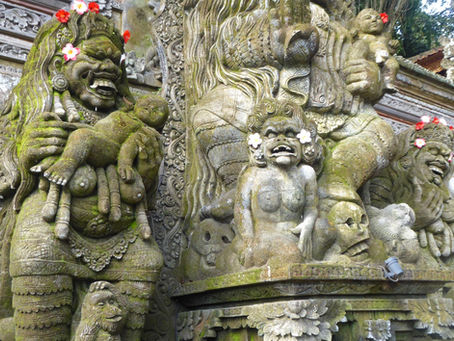top of page

GLOBAL SHANANIGANS

Search
Myths and Legends


Saraswati - The Divine Goddess of Knowledge
From an ancient river in India to a Goddess inspiring art, music and learning across Asia, Saraswati flows through history, myth and human creativity. Honoured in sacred texts, celebrated in Bali’s vibrant rituals and revered from Nepal to Japan, she embodies wisdom, inspiration and the eternal current of thought. Her presence reminds us that knowledge and creativity are never still, they ripple, dance and transform, shaping both the world and the mind.
Shannon


The Dark Mystique of Dvarapalas
In the sacred ruins and temples scattered throughout Asia, the Dvarapalas loom in silence, their colossal forms carved by hands long turned to dust. They once guarded the thresholds of kingdoms now consumed by time, their presence a testament to forgotten empires and their devotion to the sacred. To stand before them is to confront centuries of belief etched into stone, a solemn reminder that the path into the divine has always been shadowed by danger.
Shannon


Blood and Shadows - Unmasking the Leyak’s Curse
In the dark heart of Balinese folklore, the Leyak is one of the island’s most feared witches but they do not act alone. They serve Rangda, the merciless queen of black magic, whose monstrous face and pitiless power embody Bali’s deepest terrors.
Shannon


The Sacred Nāgas of Bali - Guardians of the Island
In the mystical landscape of Bali, where volcanoes brood above emerald rice terraces and the sea whispers ancient secrets, serpentine beings known as Nāgas hold a revered place in the island’s cosmology. These mythical serpent deities, often depicted as long, dragon-like creatures adorned with golden crowns and shimmering scales of green and gold, are considered powerful protectors of water, fertility and the spiritual balance between the underworld, earth and the heavens.
Shannon


Queen of Demons - The Legend of Rangda
Evoking both fear and intrigue, the Balinese divinity known as Rangda stands as a terrifying yet essential force within the island's spiritual and cultural landscape. She is more than just a monstrous figure, she is the embodiment of ultimate darkness, chaos and destruction, the shadow side of the cosmos that cannot be ignored or denied.
Shannon


Barong - King of the Good Spirits
Barong is one of the most iconic and revered figures in Balinese mythology, embodying health, good fortune and divine protection. More than just a mythical creature, Barong is believed to act as a guardian angel, accompanying each person through life and shielding them from harm. He is the leader of the hosts of good and the eternal nemesis of Rangda, the dreaded Widow Queen.
Shannon


Fangs of the Divine - Hanuman the Monkey King
Hanuman, the fierce Monkey King, prowls through the shadowed corners of Balinese myth, a figure both revered and feared. Far beyond a mere symbol of strength, he embodies a primal force, wild, untamed and relentless in his pursuit of justice. In Bali’s ancient Hindu-Buddhist tapestry, Hanuman’s presence evokes a raw energy, one that bridges the mortal world with darker realms where gods and demons wage eternal war.
Shannon


The Dark Legend of Calon Arang - Bali’s Most Feared Witch
In the black veins of Balinese and Javanese mythos, no figure evokes more dread than Calon Arang. Her story isn’t just about sorcery, it’s about what happens when society pushes a woman too far and she decides to burn the world down rather than be erased by it. She was no mere witch, she became the storm of death incarnate. The widow of Girah and the devourer of life.
Shannon


Garuda - The Immortal Hunter
Garuda, the colossal bird being of Hindu myth, soars through Balinese religious imagination not as a gentle guardian but as a relentless force cutting across the realms of gods, demons and mortals. His wings are said to darken the sky when spread, the violent wind from their beat capable of stripping the leaves from the forests.
Shannon


Dewi Danu and Dewi Sri – The Sacred Sisters of Bali
Dewi Danu rules the highland lakes while Dewi Sri dwells in the fertile lowlands, yet their powers meet within Bali’s sacred subak system. Waters from the mountains descend through canals to the rice fields, where temples serve as ritual gateways, transforming the flow of water and the growth of grain into a divine exchange between earth and goddess.
Shannon


Bedogol - The Gatekeepers
Across Bali, Bedogol refers to the guardian statues that flank the entrances of temples and family compounds, the silent watchers carved in stone. Positioned in pairs on either side of a gateway, they serve as spiritual protectors, anchoring the threshold between the ordinary world and sacred ground.
Shannon


Batara Kala - Devourer of Time and Light
Batara Kala, in Balinese mythology, is the monstrous deity of time, destruction and the underworld. He's a god born not from light but from the uncontrolled lust of the supreme god Shiva (Siwa). In one chilling version of his origin, Batara Kala is conceived during a moment of cosmic imbalance, when Shiva’s spilled seed, filled with uncontrollable rage and passion, falls to earth and takes form.
Shannon


Bhoma - Bali's Protector and Judge
In the architectural language of Balinese temples, Bhoma statues are not merely decorative but play a protective and symbolic role. Bhoma is derived from the ancient Sanskrit word bhūma, meaning “Earth” and is considered a guardian spirit linked to fertility, the forest and subterranean realms. Usually mounted above temple gates or embedded within sacred water features, these fierce, leaf entwined figures serve as guardians of spiritual boundaries,
Shannon


Ganesh - The Remover of Obstacles
In the moss veiled temples of Bali, Ganesha is far more than a familiar Hindu icon, he is a living force who moves between light and shadow. Though his roots lie in Indian Hinduism, Bali’s Ganesha (also known as Batara Gana) has taken on new dimensions, shaped by animist spirits, local rituals and the Balinese understanding of cosmic balance.
Shannon


The Birth of Apsaras - Daughters of the Ocean of Milk
Apsaras, the celestial nymphs of Hindu and Buddhist mythology, are revered for their unparalleled beauty, graceful movements and mastery of dance and music. Adorned with golden skin, fragrant hair and flowing garments, they appear throughout ancient texts as divine attendants in the heavenly courts of gods like Indra, where they serve as entertainers and symbols of spiritual and aesthetic refinement.
Shannon


The Dark Reign of Jiajing - Death by a Thousand Cuts
The Jiajing Emperor, who ruled China’s Ming Dynasty from 1521 to 1567, is often remembered for his sadistic and tyrannical reign marked by cruelty, decadence and obsession with immortality. His relentless pursuit of eternal life led him to engage in dark and brutal practices, one of the most notorious being his bloodlust for a substance called “red lead.” This concoction was allegedly made using the menstrual blood of young virgin girls.
Shannon
bottom of page